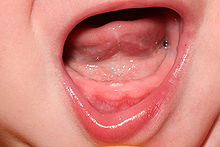

Teething is the process by which an infant's first teeth (the deciduous teeth, often called "baby teeth" or "milk teeth") appear by emerging through the gums, typically arriving in pairs. The mandibular central incisors are the first primary teeth to erupt, usually between 6 and 10 months of age and usually causes discomfort and pain to the infant. [1] It can take several years for all 20 teeth to complete the tooth eruption. Though the process of teething is sometimes referred to as "cutting teeth", when teeth emerge through the gums they do not cut through the flesh. Instead, hormones are released within the body that cause some cells in the gums to die and separate, allowing the teeth to come through.[2]
Teething may cause a slightly elevated temperature, but not rising into the fever range of greater than 38.0 °C (100 °F).[3] Higher temperatures during teething are due to some form of infection, such as a herpes virus, initial infection of which is extremely widespread among children of teething age.[4]
- ^ Lunt Roger C., Law David B. (October 1974). "A review of the chronology of eruption of deciduous teeth". The Journal of the American Dental Association. 89 (4): 872–879. doi:10.14219/jada.archive.1974.0484. PMID 4609369.
- ^ "Teething". National Health Service of England
- ^ Massignan, Carla; Cardoso, Mariane; Porporatti, André Luís; Aydinoz, Secil; Canto, Graziela De Luca; Mezzomo, Luis Andre Mendonça; Bolan, Michele (March 2016). "Signs and Symptoms of Primary Tooth Eruption: A Meta-analysis". Pediatrics. 137 (3): e20153501. doi:10.1542/peds.2015-3501. PMID 26908659.
- ^ L Jaber; I J Cohen; A Mor (1992). "Fever associated with teething". Archives of Disease in Childhood. 67 (2): 234. doi:10.1136/adc.67.2.233. PMC 1793425. PMID 1543387.